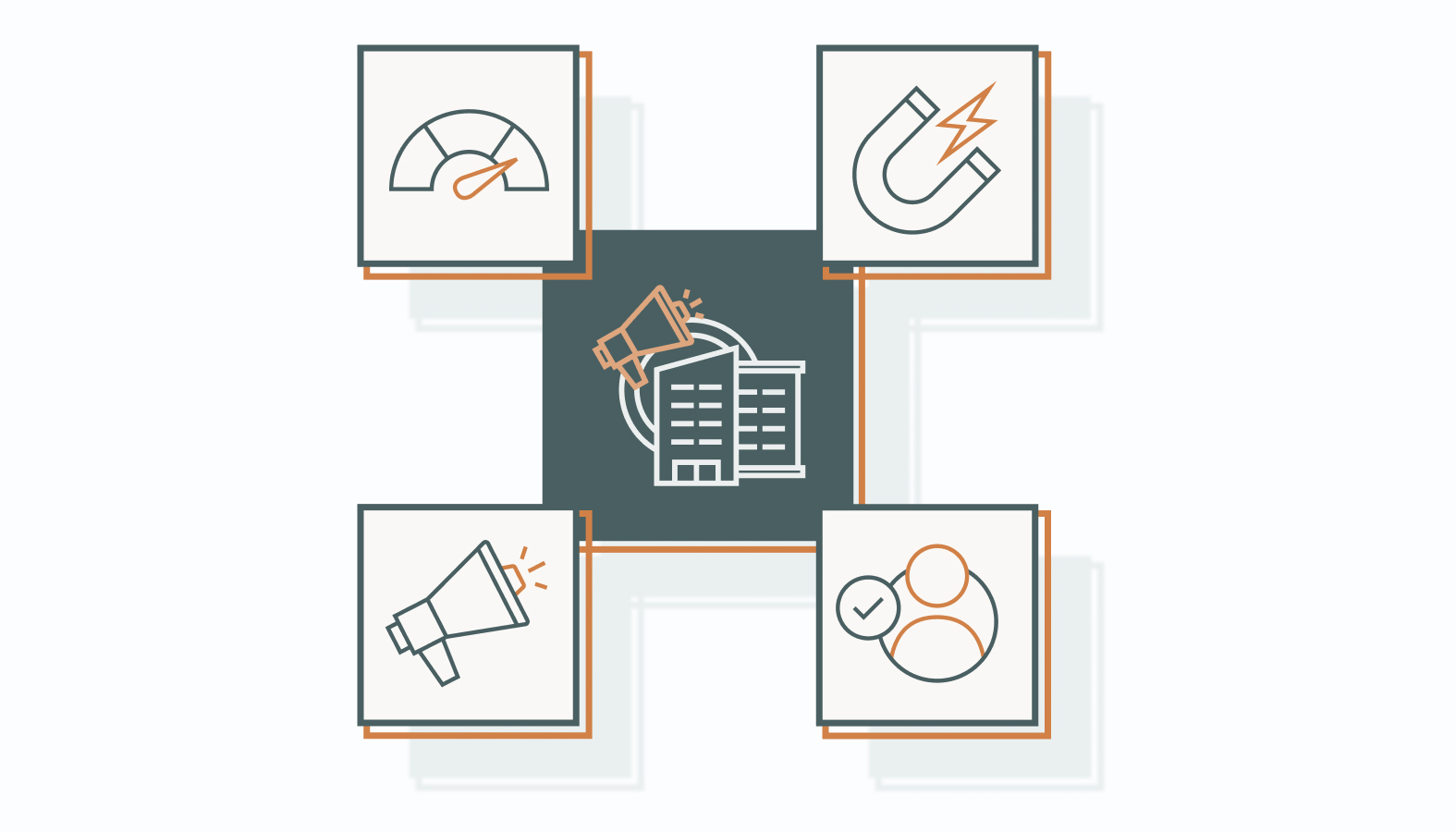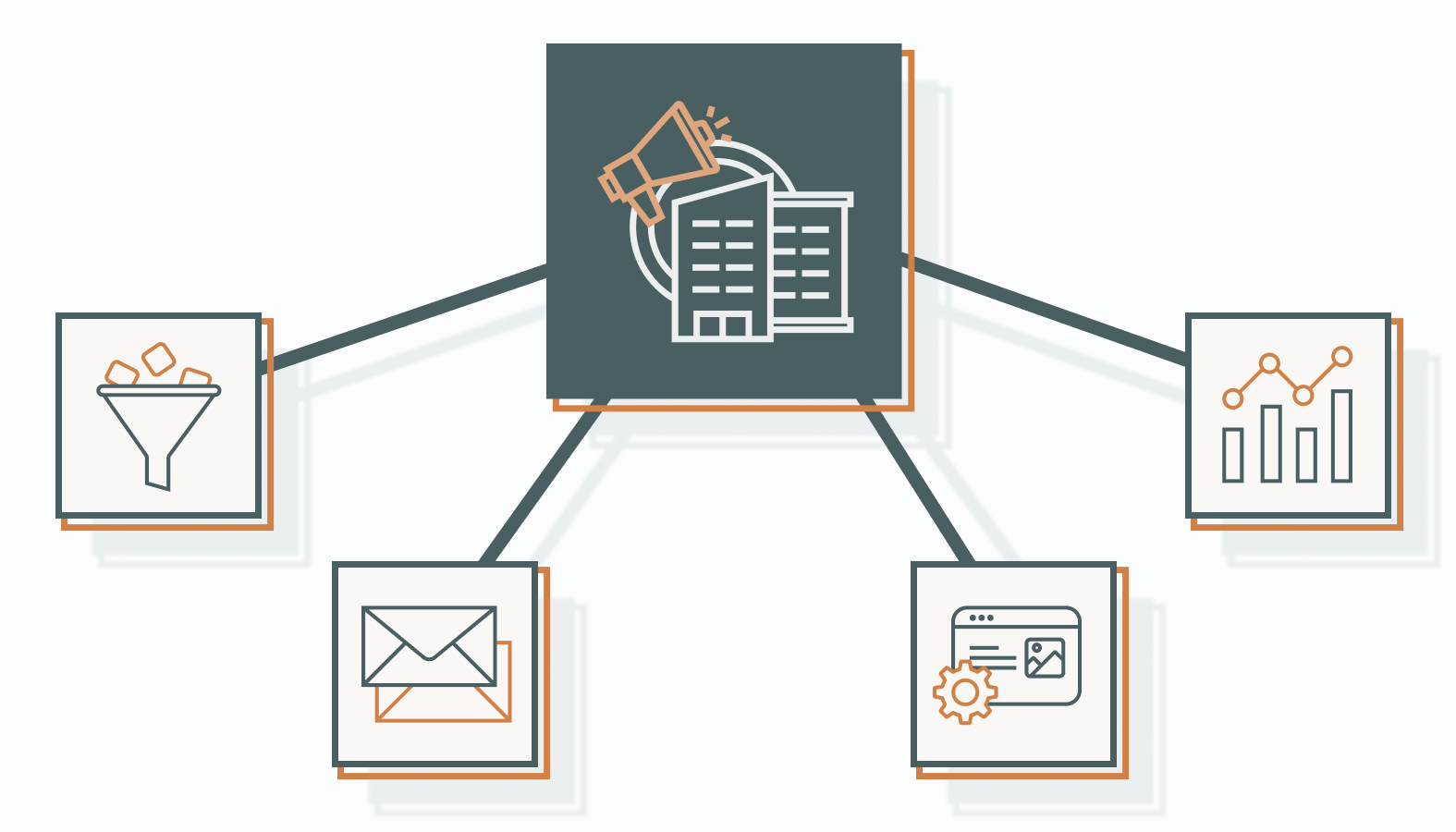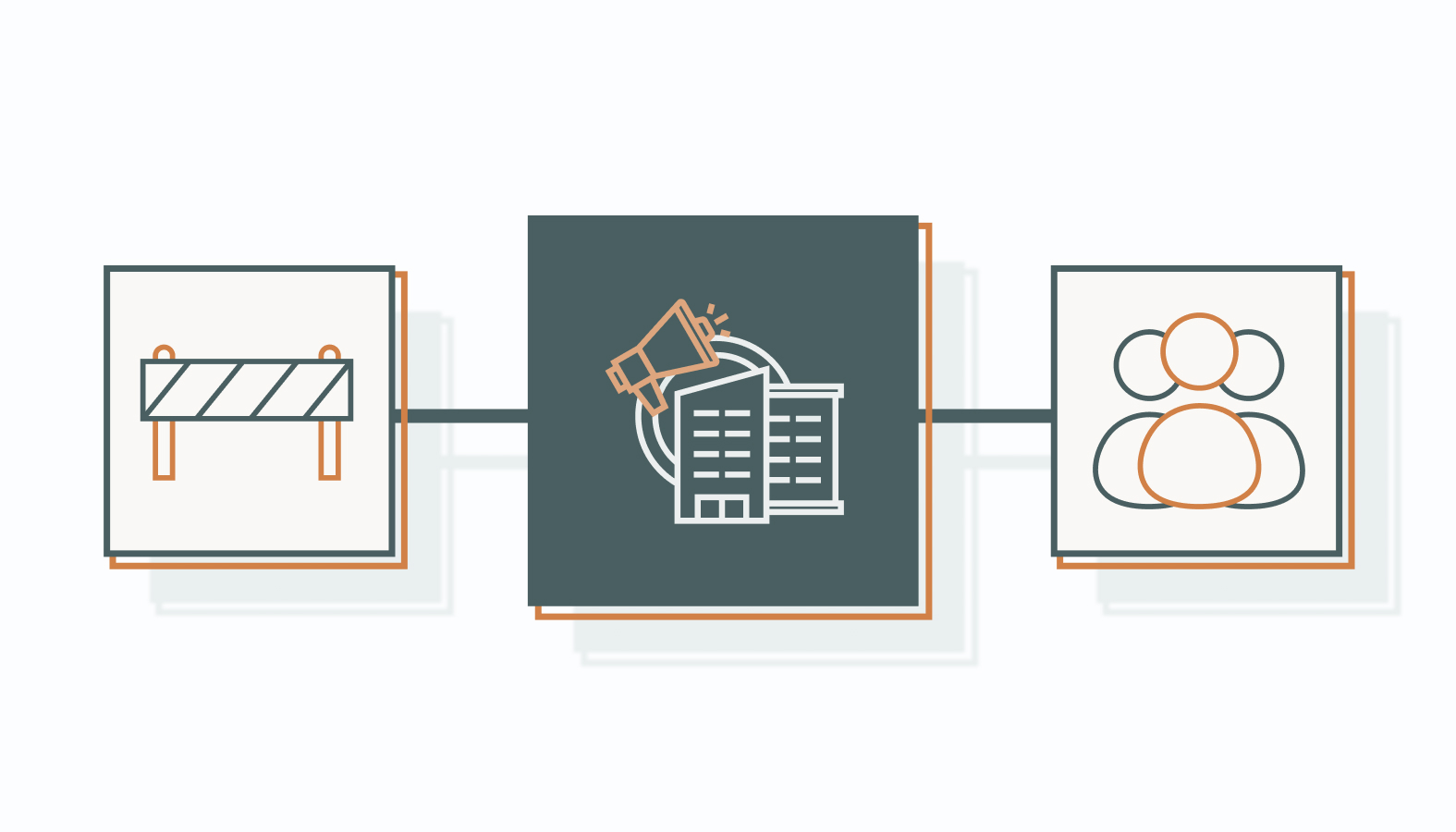Feeling stretched thin by lead nurturing, campaign timing, or team coordination? You’re not alone. In today’s complex B2B landscape, manual marketing efforts often fall short.
To meet rising expectations and scale efficiently, modern teams are turning to smarter, more automated solutions.
B2B marketing automation doesn’t replace your team; it enhances it. When executed strategically, it frees up your team’s time, generates higher-quality leads, and ensures a seamless transition to sales.
But automation isn’t plug-and-play. Without a clear strategy and alignment, it won’t deliver.
This guide explains how to do it right so you can work smarter, move faster, and drive real growth. Let’s dive in.
Mastering B2B Marketing Automation
Before automating campaigns and scoring leads, it’s essential to grasp what B2B marketing automation entails and how it functions behind the scenes.
What B2B Marketing Automation Means
B2B marketing automation is the strategic use of software and systems to handle repetitive tasks, optimize campaign delivery, and improve conversion outcomes.
At its core, it merges three pillars:
- CRM Integration
- Lead Scoring
Together, these elements streamline lead nurturing, enable personalized outreach at scale, and facilitate precise tracking of results.
Unlike B2C, which focuses on quick individual sales, B2B automation involves building trust with buying committees and guiding them through high-stakes decisions. This process demands more data, more coordination, and more finesse. Automation equips you with the tools to achieve this consistently and intelligently.
How B2B Marketing Automation Works
The engine of B2B marketing automation runs on interconnected systems.
First, CRM integration ensures every contact, click, and conversation lives in one place. This makes your lead scoring accurate, ranking prospects based on behaviors, intent signals, and stage in the funnel.
From there, automated workflows keep communication tight. Drip campaigns, triggered emails, and dynamic content delivery responds to your prospects’ actions in real-time, and the system proactively determines what they need next.
Consider this: A leading SaaS provider implemented a full automation stack and saw a 30% drop in manual marketing hours, a 20% jump in lead conversion, and a significantly higher campaign ROI. That’s not magic; that’s strategy backed by intelligent systems.
Marketing automation saves time and reshapes marketing when effectively utilized, allowing teams to think bigger, act faster, and deliver sharper results.
Unlocking the Advantages of B2B Marketing Automation
Marketing automation is more than a luxury; it’s a force multiplier. When implemented correctly, it streamlines execution and fosters more thoughtful engagement at scale. Here’s what it can unlock.
Boosting Efficiency and Reducing Costs
Marketing automation reduces friction by streamlining how teams execute campaigns. Email sequences, social scheduling, and data analysis operate in the background, allowing marketers to reinvest time where it counts: creative and strategic output. This results in enhanced team velocity without inflated headcount.
Automation also cuts overhead. Innovative tools like lead scoring systems automatically identify high-value prospects, so your sales team spends less time chasing and more time closing deals. Every touchpoint becomes sharper, reducing the cost of acquiring new customers.
Generating and Nurturing High-Quality Leads
Automation platforms excel at identifying quality leads using behavioral and demographic data. Once prospects enter the funnel, automated workflows ensure consistent engagement without manual follow-up.
From triggered emails to personalized content sequences, these tools adapt outreach based on prospect behavior, guiding them through a relevant journey that converts interest into intent.
Strengthening Sales and Marketing Collaboration
Automation bridges the historical divide between sales and marketing. By syncing CRMs and providing real-time campaign insights, it aligns both teams around shared goals and performance metrics. This clarity transforms potential tension into collaboration.
Unified platforms provide both departments access to the same customer data, from initial touch to conversion. This not only accelerates handoffs but also improves pipeline accuracy and win rates.
Elevating the Customer Experience
Personalization scales effortlessly through automation. Tailored emails, content, and offers can be triggered based on customer behavior and preferences, delivering relevance that feels human, not robotic.
More importantly, it enhances responsiveness. Automated systems ensure timely follow-ups and prevent support delays. Customers feel heard and supported throughout the lifecycle, fostering loyalty and long-term value with every interaction.
How to Successfully Implement B2B Marketing Automation
Rolling out B2B marketing automation isn’t a plug-and-play exercise — it’s a strategic shift. The real win comes from aligning your tools, teams, and workflows to work harmoniously.
Here’s how to implement it without the chaos, lead leakage, or internal friction.
1) Select the Best Tools for Your Business
Start with the proper foundation: your tech stack. Your platform should scale with your growth, support your marketing complexity, and be intuitive enough for your team to use effectively. Prioritize:
- Scalability: Will it still work when your lead volume doubles? Ensure the platform can grow with your business and accommodate increased data and user demands.
- Features: Can it handle your unique workflows, reporting needs, and CRM syncs? Look for comprehensive features that align with your specific marketing needs.
- Usability: Is it designed for marketers or developers? Opt for intuitive and easy-to-adopt tools that minimize the learning curve and maximize productivity for your team.
Popular platforms like HubSpot, Marketo, and Pardot each offer distinct strengths, from user-friendly CRMs to deep Salesforce integration. The best choice depends on what fits your business model and team maturity, not just the feature checklist.
2) Craft a Strategic Automation Plan
Automation only works when it’s purpose-built. That means mapping every workflow to a real goal, not just automating for automation’s sake.
Get tactical:
- Set clear objectives. Define what you aim to achieve with automation, whether it’s boosting conversions, deepening engagement, or streamlining operations.
- Segment audiences based on real buying behavior. Identify your ideal customers and group them by real buying patterns to tailor messaging effectively.
- Map customer journeys. Outline key touchpoints from awareness to purchase where automation can drive impact.
Everything you automate should push toward measurable outcomes. If it doesn’t, reconsider or refine it.
3) Manage Integration and Data Efficiently
Disconnected data quickly undermines automation. Integrate systems using APIs or middleware properly to ensure impeccable data hygiene.
- Sync your CRM, analytics, and automation platforms to keep insights actionable and campaigns on target.
- Run regular audits, clean your lists, and stay ahead of privacy regulations like GDPR and CCPA. Good data must be clean and compliant.
When your systems communicate, your strategy clicks. And that’s what turns automation from a shiny tool into a performance engine.
Maximize Your Automation Impact with Proven Strategies
Automation isn’t magic—it’s leverage. The tools themselves won’t move the needle unless they’re part of a smarter, scalable strategy. Real ROI comes from how precisely and purposefully those tools are used.
This section covers practical strategies for transforming your automation stack into an efficient, targeted, scalable revenue engine.
Lead Scoring and Nurturing
Lead scoring is your first filter for distinguishing browsers from buyers. Assigning weighted scores based on engagement behavior and buyer stage allows your team to focus on leads that are genuinely ready to move. Lead scoring is prioritization grounded in data.
From there, smart nurturing takes the lead. Automated workflows should feel anything but robotic. Focus on timely, relevant touchpoints like personalized emails and contextual content offers that build trust and move prospects through the funnel. When done right, this kind of automation keeps your pipeline warm, active, and steadily progressing.
Automated Email Marketing
Email remains the heavyweight champion of ROI, but only when automation is used with precision. It’s not just about sending messages on autopilot but delivering them to the right person at the right time.
Here’s how to make it work:
- Segmentation: Group your audience by behavior, lifecycle stage, or purchase history. One-size-fits-all is a fast track to the trash folder.
- Content Customization: Dynamic content lets you speak directly to each segment’s needs and interests at scale.
- Performance Tracking: Data is your editor. Monitor open rates, CTRs, and conversions religiously. Use that feedback to fine-tune and iterate.
When automation meets intentional strategy, email stops being noise and starts driving action.
Social Media Automation
Consistency matters in social media, but so does humanity. Tools like Buffer, Hootsuite, and Sprout Social help you maintain a strong cadence across platforms, freeing up bandwidth for more strategic work.
But here’s the nuance: don’t let automation replace authentic engagement. Schedule your content, but make sure to also jump into conversations, respond in real-time, and encourage user-generated content. Social is a dialogue, not a monologue. Let automation support that, not suppress it.
Analytics and Reporting
Data without action is just decoration. Automation tools generate many reports, but the real value lies in turning those insights into decisions.
To make your analytics work for you:
- Track What Matters: Align your metrics with business objectives. Consider tracking revenue influence, lead quality, and customer lifetime value.
- Act on Insights: Use trends to guide your strategy: double down on what’s working and adjust what isn’t.
- Review Routinely: Set regular checkpoints to evaluate performance. Marketing shifts quickly, and your strategy should, too.
With these proven tactics, automation stops being a checkbox and becomes a competitive advantage. When you pair the right tools with a sharp strategy, you save significant time and scale impact.
Challenges and Solutions in Marketing Automation
Marketing automation promises the kind of efficiency and scale every marketer craves, but the reality isn’t always so seamless. Even the most advanced tools fall short without precise execution. The pitfalls are real: fragmented data, robotic customer interactions, misaligned teams, and murky ROI tracking can all derail your automation strategy.
This section breaks down the most challenging hurdles marketers face with automation and the solutions that would keep your campaigns agile, your customer connections genuine, and your results measurable.
Avoiding Common Pitfalls in Automation
Automation isn’t a set-it-and-forget-it play.
The biggest stumbles often come from shaky data integration, loss of personalization as you scale, marketing and sales operating in silos, and unclear ROI.
Address this head-on, and your automation strategy goes from clunky to clinical.
Overcoming Data Integration and Quality Challenges
Data is the fuel behind automation, but when scattered across systems or riddled with inconsistencies, it’s more of a liability than an asset.
Integrating diverse data streams requires tools that talk to each other without friction.
- Use robust integration platforms like Zapier or MuleSoft to stitch systems into a smooth, reliable flow.
- Establish transparent data governance (rules and standards) that keep your data clean, consistent, and actionable.
Without this discipline, automation turns into trial and error.
Scaling Personalization Efforts Effectively
Personalization is the secret sauce that turns automated messages into meaningful conversations. But as your campaigns grow, maintaining that personal touch gets tricky.
- Tap AI-driven audience segmentation to deliver laser-focused messaging.
- Employ dynamic content that adapts to each user’s preferences and behaviors, keeping interactions relevant without manual heavy lifting.
This balance ensures your messaging resonates without drowning your team with endless customization.
Bridging the Gap Between Marketing and Sales
Automation magnifies any disconnect between marketing and sales. Leads slip through the cracks when these teams aren’t aligned, and opportunities get lost.
To bridge this gap, businesses can:
- Implement Shared KPIs: Establishing common performance indicators aligns goals and fosters collaboration.
- Regular Communication: Frequent meetings and updates ensure that both teams are aligned and informed.
- Integrated Platforms: Consolidate marketing and sales data to facilitate transparency and coordination.
Accurately Measuring ROI and Impact
Tracking ROI in an automated ecosystem with multiple touchpoints isn’t straightforward. It demands clarity and the right tools.
For accurate measurement, consider:
- Defining Clear KPIs: Establish specific, measurable goals to benchmark success.
- Using Analytics Tools: Platforms like Google Analytics or HubSpot offer insights to refine strategies.
- Conducting Regular Performance Reviews: Periodic evaluations ensure campaigns remain aligned with objectives and deliver the desired impact.
Measuring with rigor turns automation from a black box into a growth engine.
Equipping Your Team with Training and Support
Tools alone don’t win. Your team’s proficiency determines how far automation can take you.
- Provide hands-on training to build confidence and competence.
- Share industry best practices so your team stays sharp and compliant.
- Offer ongoing support and resources to troubleshoot issues and embrace new features.
When your people lead the charge, automation moves from a tool to a true competitive advantage.
Harnessing Automation to Drive Sustainable B2B Growth
B2B marketing automation is more than technology — it’s a strategic edge. When executed thoughtfully, it reshapes how businesses engage prospects, align teams, and scale with precision.
Success lies in selecting the right tools, syncing processes, and evolving your strategy through real-time insights.
As competition intensifies, the future favors businesses integrating strategic automation into their core marketing and sales functions.
Take Your B2B Marketing Automation to the Next Level
Automation can sharpen your marketing, boost efficiency, improve lead quality, and unite your teams around shared goals. If you’re curious about how customized automation can accelerate your business, let’s talk.
Let’s discuss how automation can be a core part of your marketing and sales success. No pressure, just practical advice from experts who’ve helped B2B teams transform their approach and achieve meaningful results.
Schedule a candid conversation with one of our experts today and unlock your next growth opportunity.









